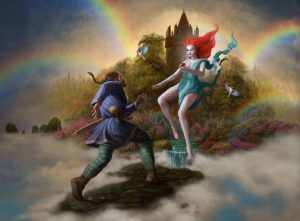
Reincarnation was an important aspect of the Celtic worldview. Because of this belief, the Celts did not identify a particular place that one went to after death and had no concept of heaven or hell.
Instead, the Celts believed there was a home for their supernatural figures, a place where humans occasionally strayed during life, or where they rested between lives. They referred to this place as the Otherworld.
The Otherworld appears in two different forms: the sidhes (shee) or caers (car), and the island otherworlds. Throughout the stories of Celtic goddesses, one finds reference to their origins in either a sidhe, or in a land located far out to sea, in a lake, or a river. These realms, protected by strong magic, were always hidden to normal human sight.
Many of the Celtic goddesses and gods are referred to as members of the Tuatha deDanann (too-AHdjay dan), who were the fifth wave of invaders to arrive on the shores of Ireland. They were later supplanted by the Milesians, from whom the modern Irish descend. But the Tuatha deDanann were not completely destroyed; they simply moved their kingdoms underground. It was believed that they lived magical lives in the neolithic structures of long barrows and hollow hills. Brug na Bóinne (Newgrange), the home of Celtic Goddess Boann, is one of the most famous. From another, sister goddesses Aine, Fenne, and Grainne would ride out astride their horses when the moon was full, laughing and playing the night away.
The Welsh called the dwellings of their deities caers: for example, Sky Goddess Arianrhod brought the souls of dead warriors to her revolving castle in the North Sea, Caer Arianrhod, where they awaited the time of their rebirth.
The Otherworld was a place where humans were given sacred gifts. These gifts allowed the visitor to bring back a higher state of consciousness to the everyday world of humans.
Unlike the Irish sidhes and the Welsh caers, where the deities acted much like humans, complete with power struggles and strife, the island otherworlds were places of peace, happiness, and eternal life, where the goddesses and gods lived without the pains and struggles of earthly existence. These places emanated the radiant light of eternity.

But these islands could not be stumbled upon through mist, fog, or happenstance like the sidhes could; they were difficult to access. Nor were these island otherworlds places where souls went after death. They could only be reached while living, by purposefully undertaking a difficult journey, or by invitation.
The island otherworlds were known by many names and given different locations: for example – Emhain Abhlach: Plain of Apples, Inis Subai: Isle of Joy, Tír na mBan: the Land of Women, Tìr fo Thonn: the Land Beneath the Wave, Tìr Tairnigir: the Land of Promise, TechnDuinn: House of Donn, and Hy Breasil: Most Best Place – to name just a few.
Another name for the otherworld was Tír na nÓg (Land of Eternal Youth), located beyond the western edge of the known world. The tale of Niamh of the Golden Hair and her love for Oisin, the great warrior poet of ancient Ireland, is the most well-known tale of Tír na nÓg (TCHEER na nogue).
Generally, once a human entered an island otherworld he found himself there for eternity. But at times they returned, as Oisin did, who foolishly left Tír na nÓg – longing perhaps for the drama of his old home – but was unable to make his way back, and perished as any 300-year-old man would. And in another instance, the Sea God Manannan mac Lir brought Cormac Mac Airt to the islands for only a short visit, giving him magical items, including the cup of truthfulness.
The many goddesses of the Otherworld possess great regenerative and healing powers, often having the ability to transform into swans or songbirds, or to enlist the help of those birds to accomplish good deeds. Rhiannon’s birds were known to heal the sick or ease their passage to the other side.
The apple, symbolic of all that is good and sweet in life, is almost always associated with the Otherworld Islands. It is believed that bees came to our world from Brigid’s apple orchard in the Otherworld.
The Celtic belief in an otherworld paradise, where one could learn or one could rest between lives, must have played a central role in the Celtic passion for life, the honoring of poetry and art, and courage on the battlefield. Life was meant to be lived to its fullest, with the knowledge that death was simply the passageway to the Otherworld. Here, one would pass their days and nights immersed in beauty, peace, and love while waiting the call to return to the school we call life.




















Leave a Comment